When I moved into my new house 6 weeks ago I could not wait to get started on my new garden and I must admit that unpacking my stuff and getting my house sorted has been a slow process as my garden is calling for me to come out every spare minute I have. It has been an exciting process to discover what I actually have inherited, but at this point it is a bit daunting too, with all the decisions I have to make. I have been blogging about my old garden for 4 ½ years and I have learned so much from all of you kind and experienced gardeners out there, and over the years I have been contributing in my small ways with my share of hints and tips and trial and errors too. Now I am calling on all of you gardeners to come with your helpful advice to some of the tasks, problems and decisions I am facing in my new garden, perhaps together we can come up with some solutions :-)
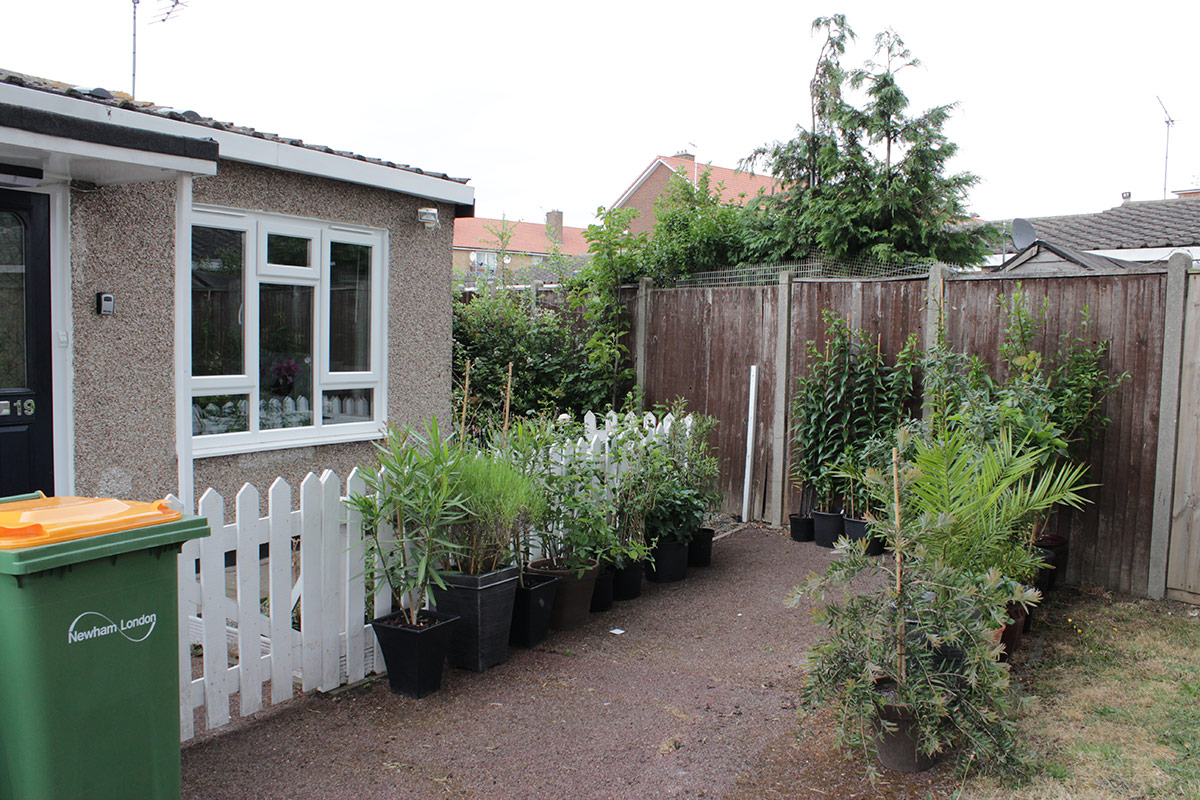 |
My front garden is going to be filled with fuchsias, the area behind me has huge trees which gives the front garden only dappled sun when the trees are in leaf so perfect for fuchsias. The ground is hard as concrete, I have not yet been able to dig ANYTHING up, not even small weeds, every time I stick a spade or a trowel in the ground I just have to give up, wherever I try, even under the bushes in the back garden. I will try to pour water and lay plastic here on the inside of the fence so I can start planting some of the fuchsias, but I am not sure it will be enough. I really miss the lovely soil I had in my old garden where I could just sit on my stool and dig with a trowel. Any good tips for loosening hard, unworked, unloved soil would be very welcome. Out here at the front of my house I will be keeping pots, the tarmac makes it impossible to plant anything but that’s OK, some plants will be fine to just stay in containers. Notice the unpruned Leylandii in the adjacent garden? Ugh, I detest them…
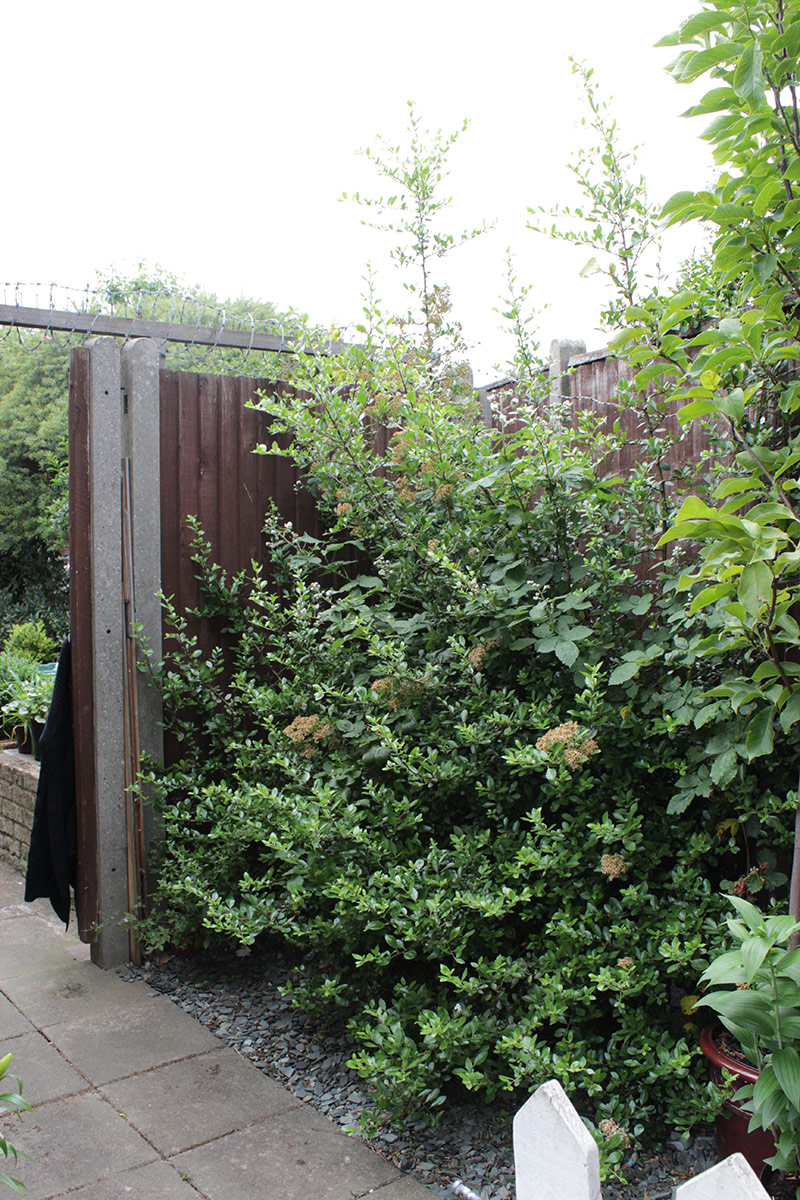 |
In the corner in front of the gate is yet another pyracantha, I wonder how many I have found now – 8 maybe? This one might be allowed to stay, although I will prune it and possibly try to train it up against this fence so I can plant something under it – and get all the brambles out of it, there are loads entwined. Proper clothing will be a must! Oh, and the barbed wire is going too, I think it looks like a prison, I will ask the council to send someone to take it off, hopefully they will do it for me, can’t see any reason to have it, it’s certainly no deterrent for thieves, if they want in, they will climb in, barbed wire or not.
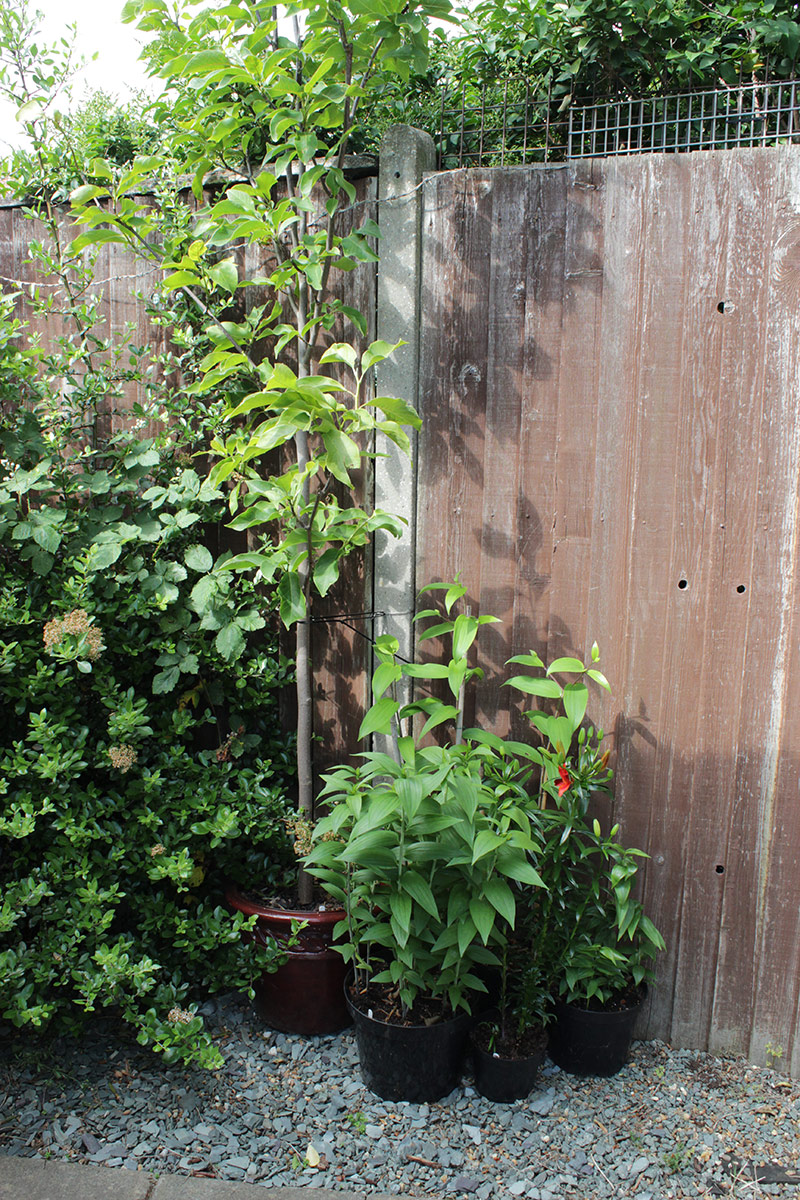 |
Next to the pyracantha is my tall magnolia growing in a container, it would be very happy to get in the ground soon and I think this space would be a nice place for it, only worry is the morning sun which comes up here, although early in March, when this one is flowering, the sun would possibly come up further down, behind the trees – this is the difficulties with a new house and garden – ideally one should not plant anything until after a whole year to see things like that. But I don’t think my potted plants can wait a whole year. Apart from the magnolia, the space outside the back gate is mainly occupied by my lilies. There are a few here and the tallest ones are on the first photo, outside the white fence.
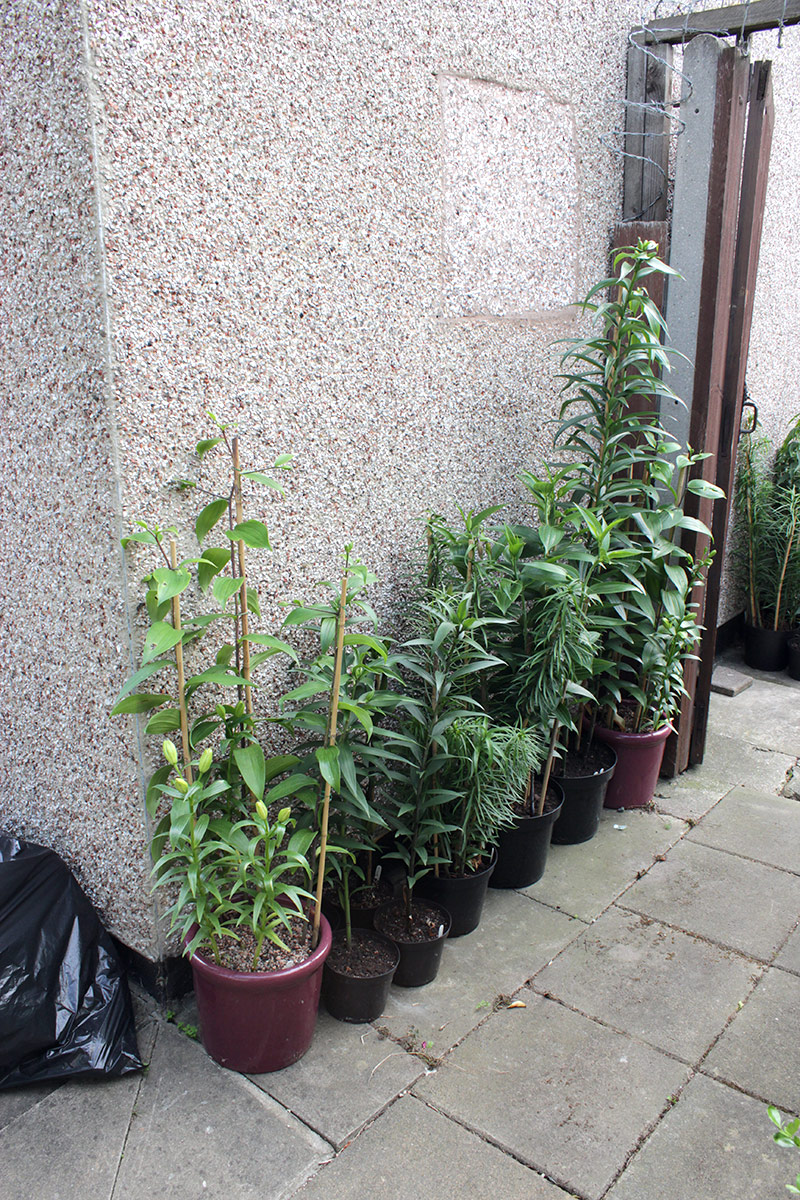 |
There are some lilies here on the left side before the back gate.
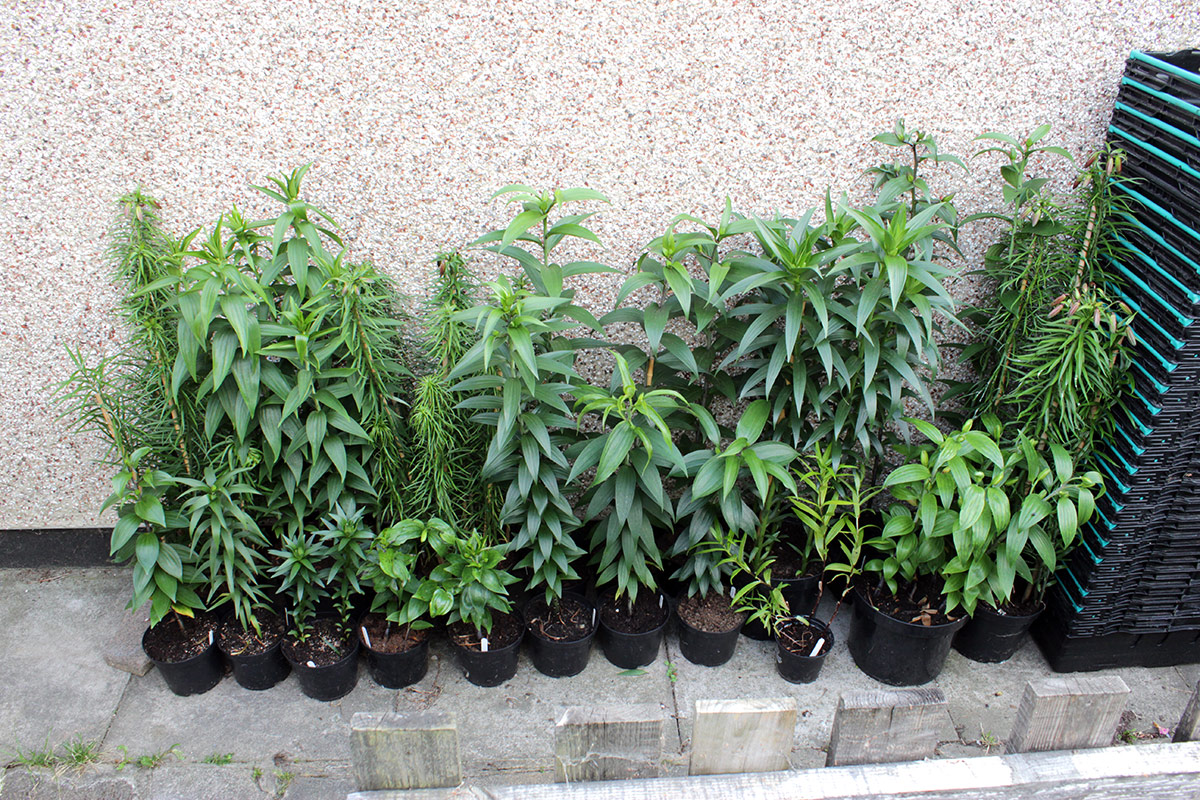 |
And many more just inside the back gate. I staked them all last week and counted them as I did them. I left many lily bulbs in the ground in my old garden as I could not be bothered lifting them all, I had no idea I had taken so many with me – in total I have 164 lilies squeezed into 40 pots. They flower at different times and are placed in various degrees of shade and semi shade so will flower over a long period, starting with the deep red Asiatic lilies which are already flowering and ending with the huge Goliath lily 'Miss Feya' in September/October. Eventually they will all be planted in the ground – if I could only manage to get a spade in the ground!
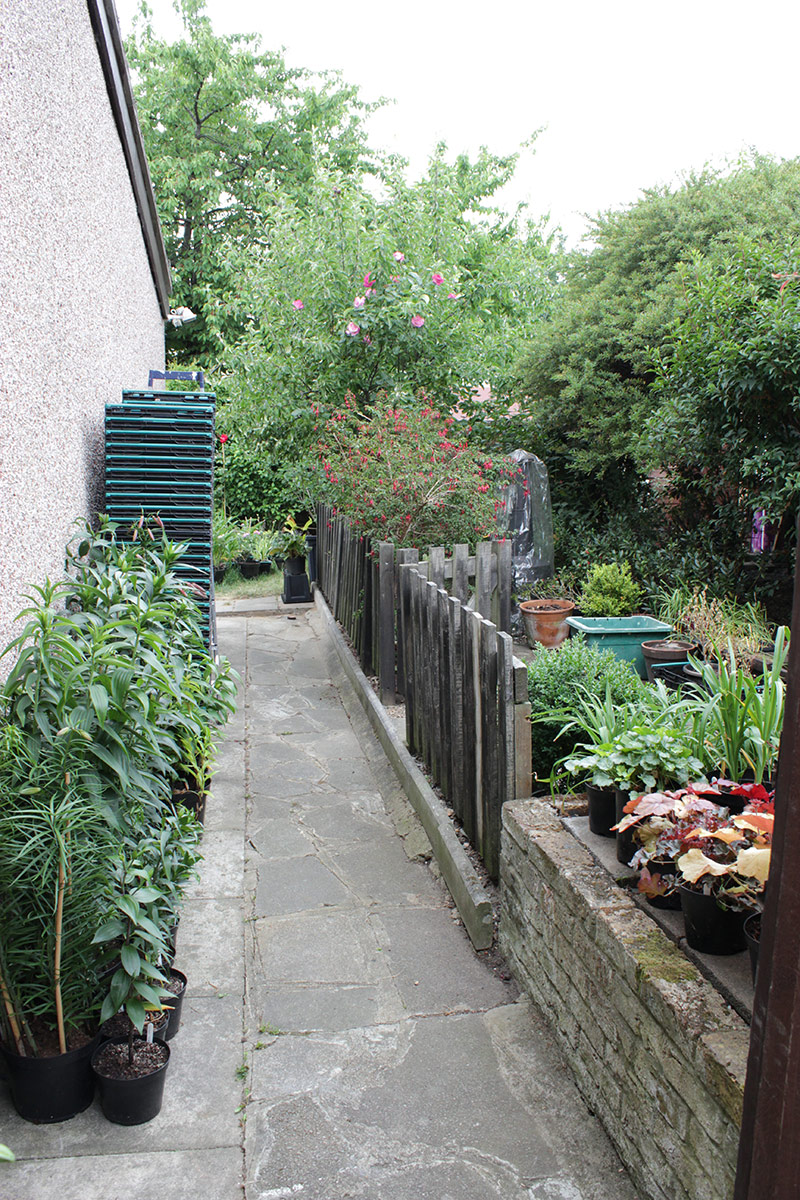 |
Once inside the back gate, apart from all the lilies, what meets you is the apple tree with the lovely climbing rose in the centre of this photo, and the huge ceanothus to the right here.
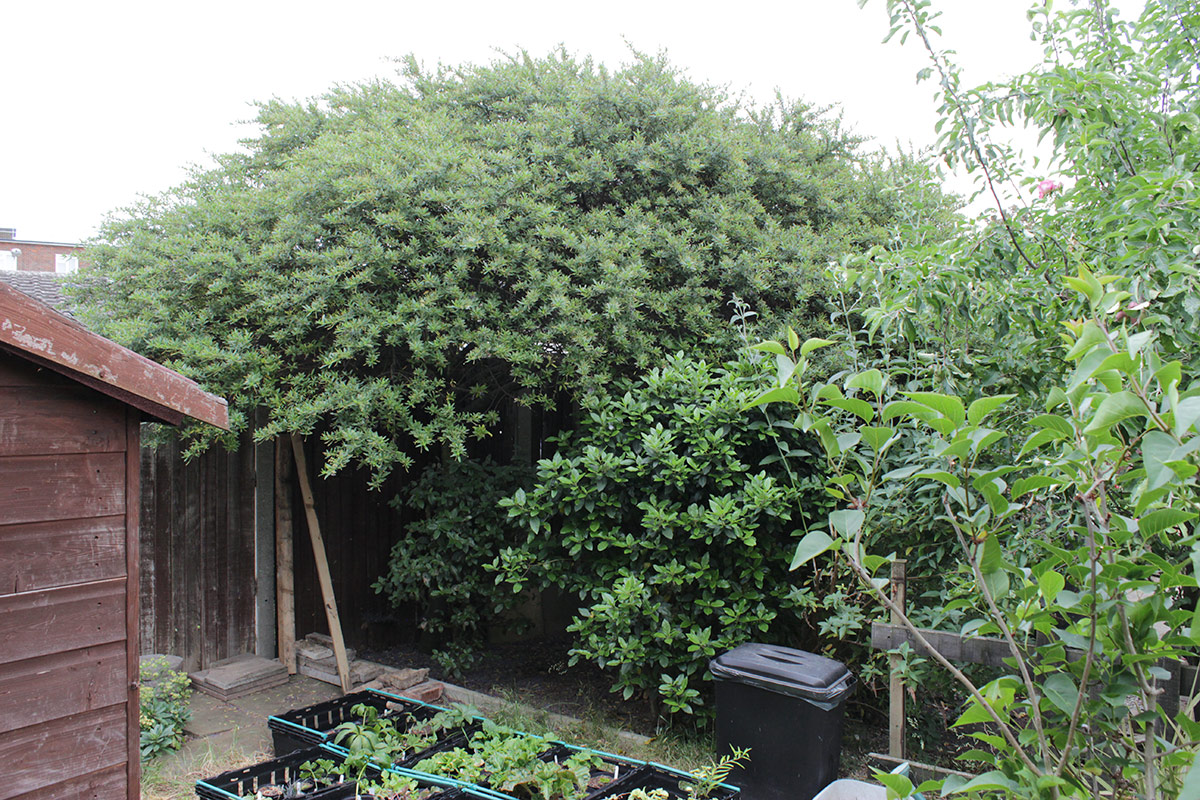 |
Here is the ceanothus seen from the other side, standing inside the garden.
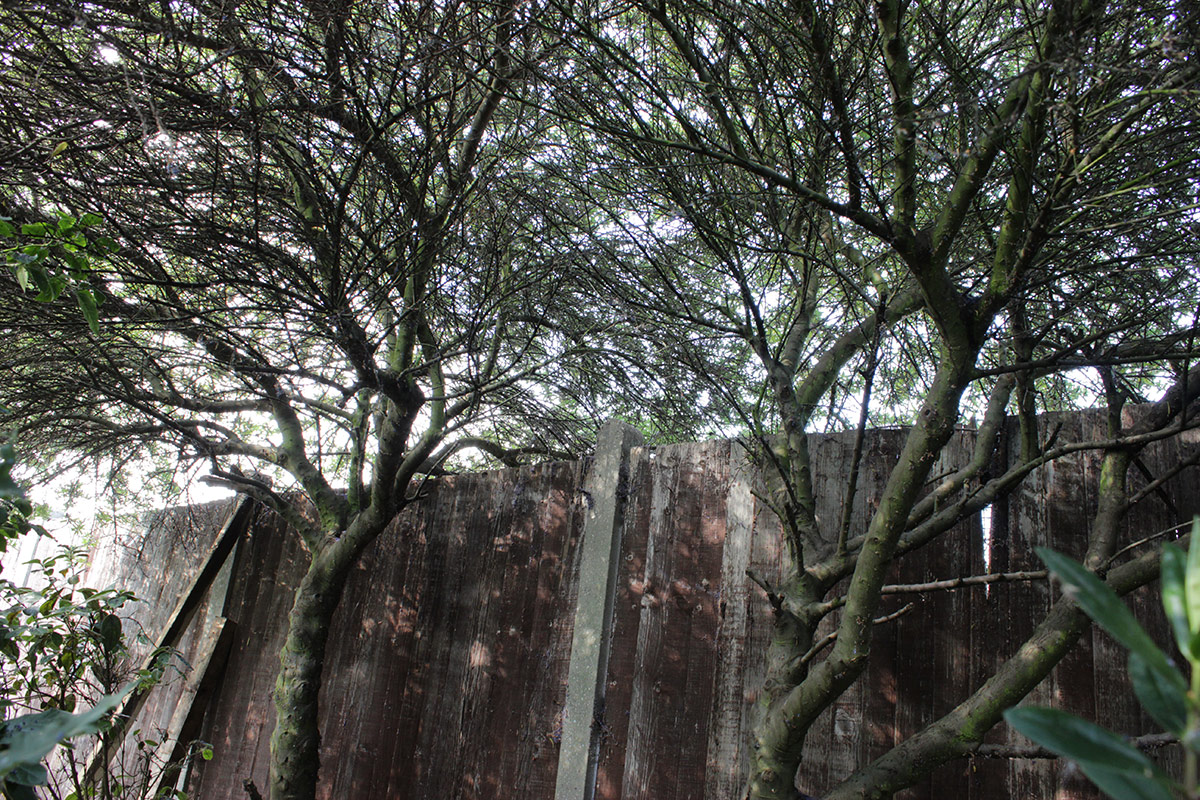 |
Walking under the ceanothus it reveals it is actually TWO bushes – or should I call them trees? At this size they are more treelike.
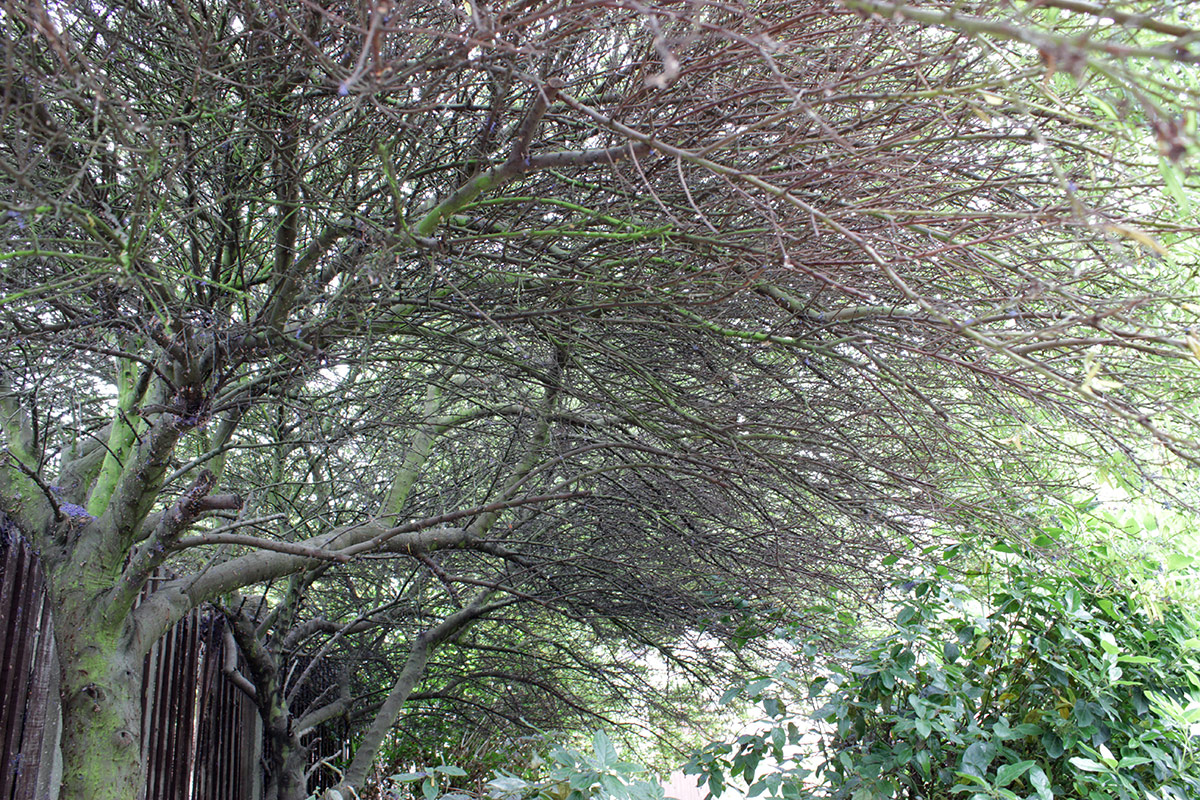 |
Even though the outside is green and produces an enormous amount of flowers that spread all over the garden like a blue dust, the inside is a mess of dead twigs. I would like to take out some of the dead branches to make room for plants growing under them, but I am unsure of how much I can prune them. I have heard that canothus doesn’t take well to pruning but does that include dead branches without leaves or just healthy ones? Anyone got experience with such a mature ceanothus? I have done some research but all I can find is ‘don’t prune spring flowering ceanothus’, which isn’t really helpful :-)
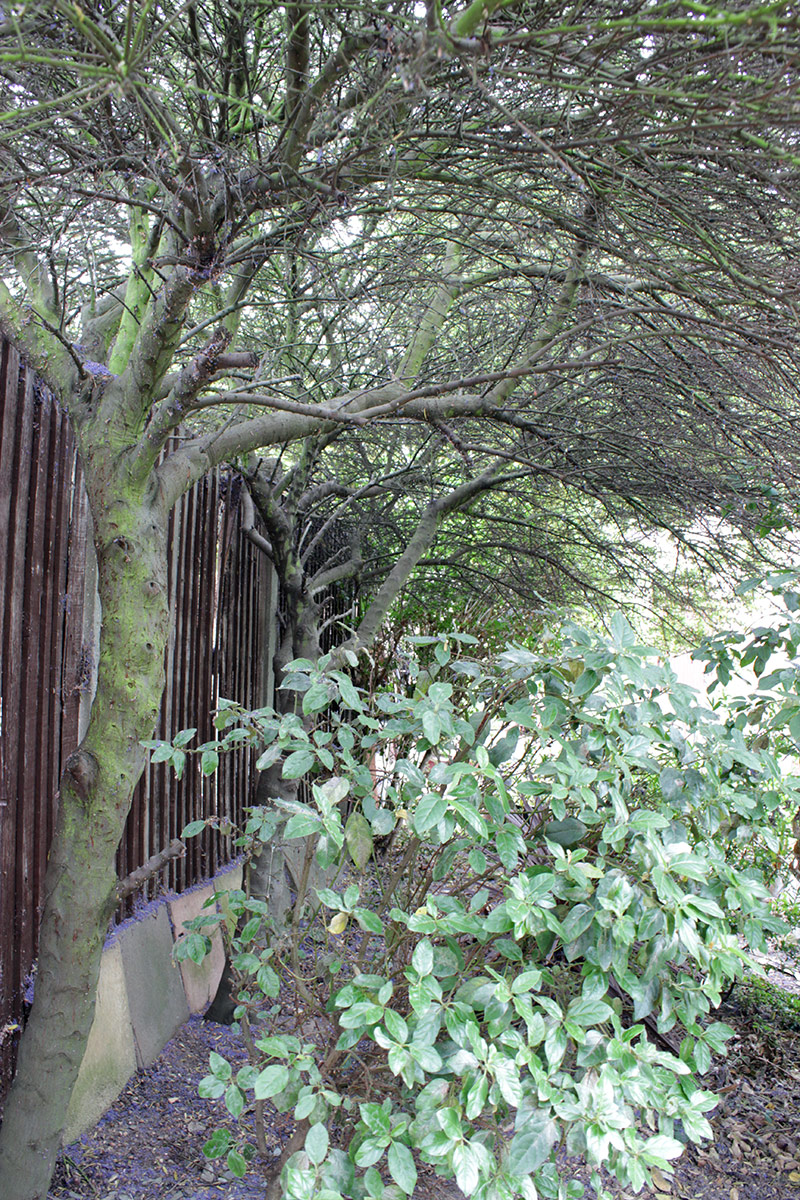 |
Under the two ceanothus’ are a few straggly bushes that I am not sure what are, they don’t look very nice and I have loads of shade loving plants waiting to be planted that would be perfect under the canopy once the soil has been improved a bit – a lot – a lorry load of soil would be nice, if someone would offer to come and spread it for me!
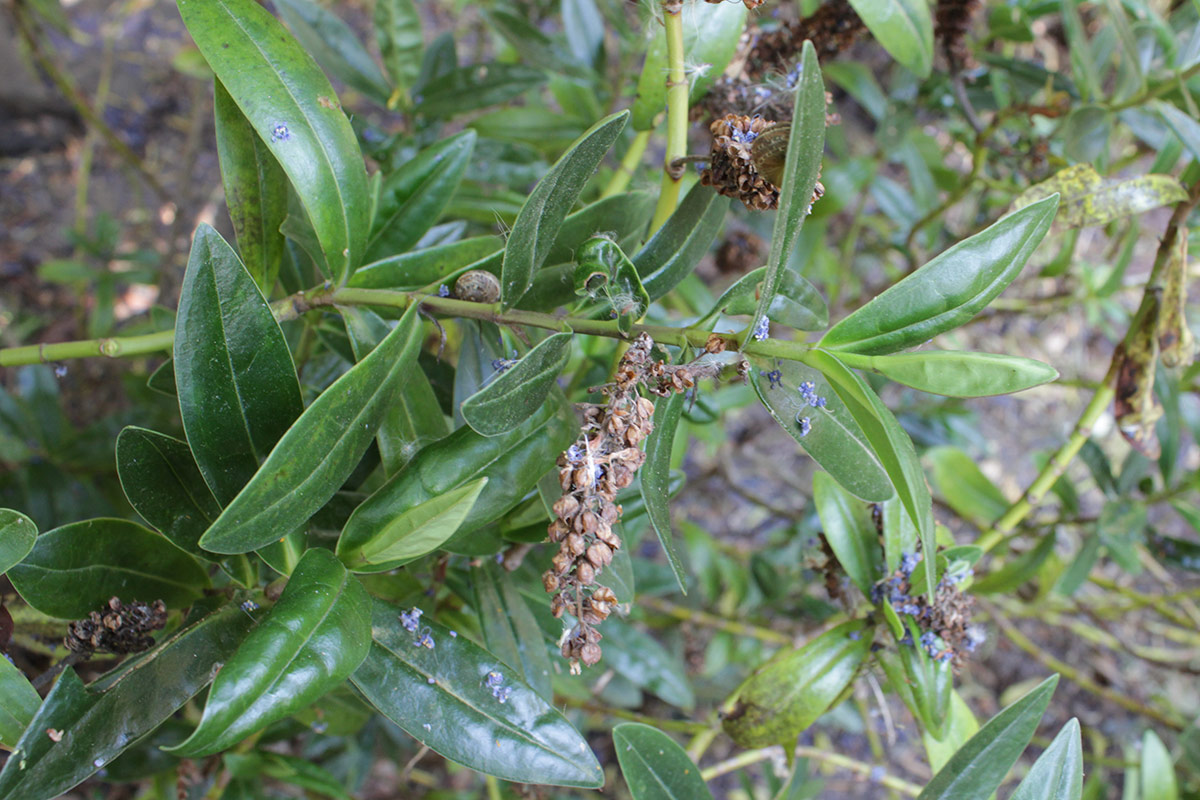 |
Here is one of the plants close-up with last years’ flowers still on. A type of hebe? Or something else? Anyone recognise this? The blue stuff on it is dead ceanothus flowers and not from this plant.
 |
I have never owned an apple tree, or any fruit tree for that matter so inheriting a garden with one apple tree, two plum trees, a cherry tree and another, huge cherry tree hanging over my garden was a treat – but also something I need to get clued up about. This is the apple tree, with branches hanging low right where I walk. I would like to remove some of the branches so I can safely walk under it without getting the branches in my face every time I forget to duck. It would also be nice to not get so many spiders and greenflies and other insects in my hair from sweeping low branches but can I just saw off those I don’t want and lift the crown so it looks nice and even? Or is there some rules here, can it be done any time of year for example?
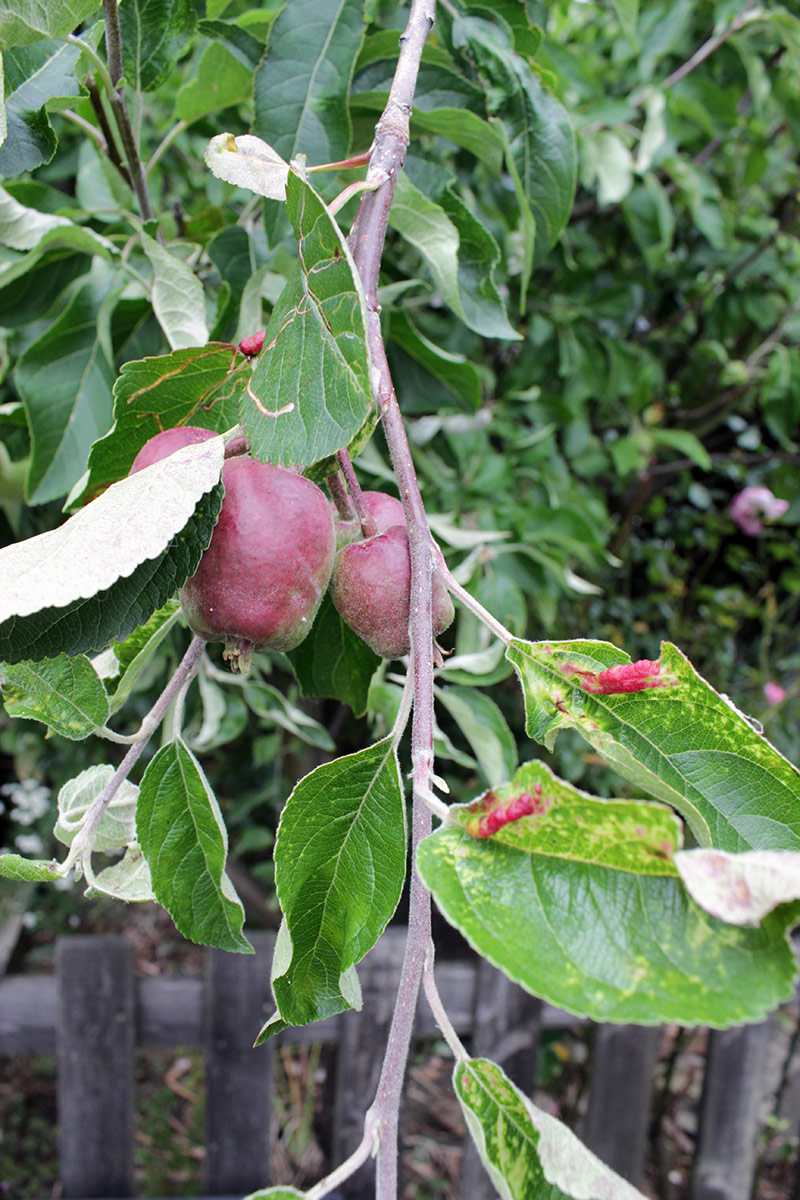 |
The apple tree doesn’t look very healthy to me, but who am I to say – I have never had an apple tree before! I found this branch with some red marks on the leaves, doesn’t look right…..and these apples look far more red than the tiny reddening on the rest of the apples. I cut this branch off, it was low and in the way anyway, it was the only branch I could see with this, but the tree is so tall I can’t possibly inspect the whole of it.
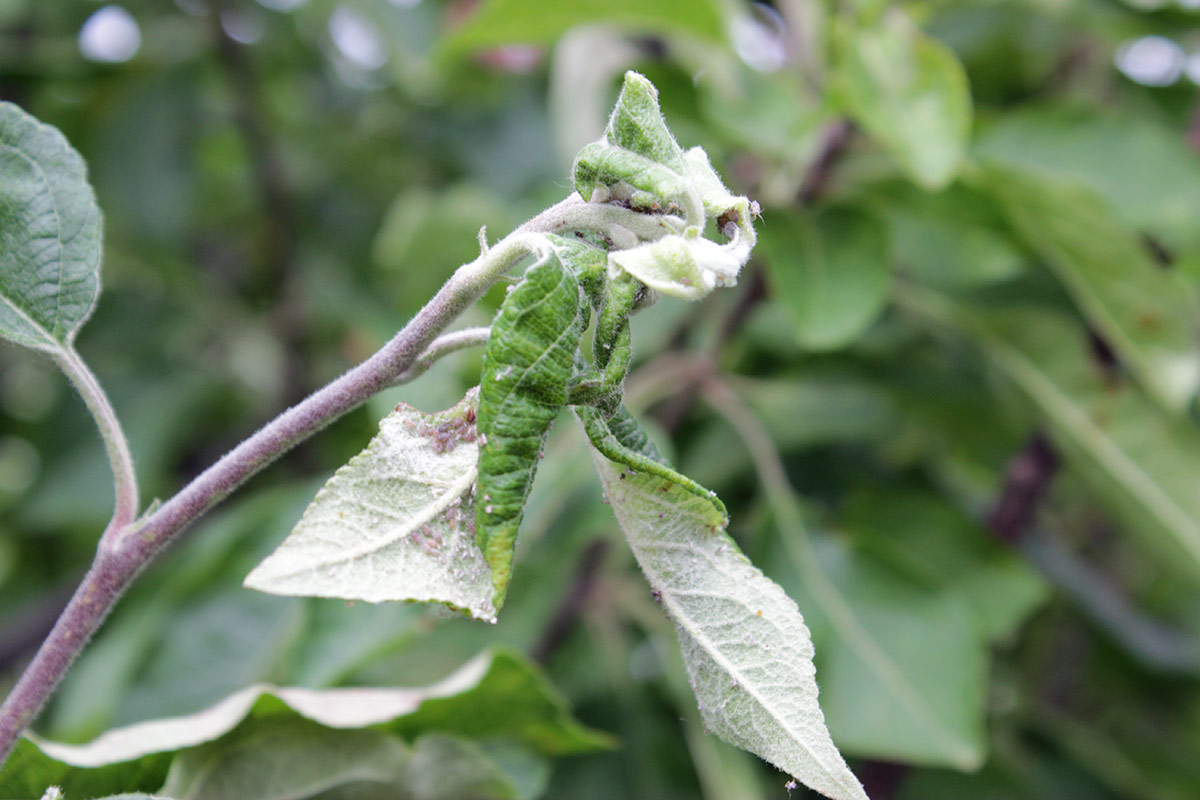 |
Some of the leaves look like this, twisted from a type of aphids.
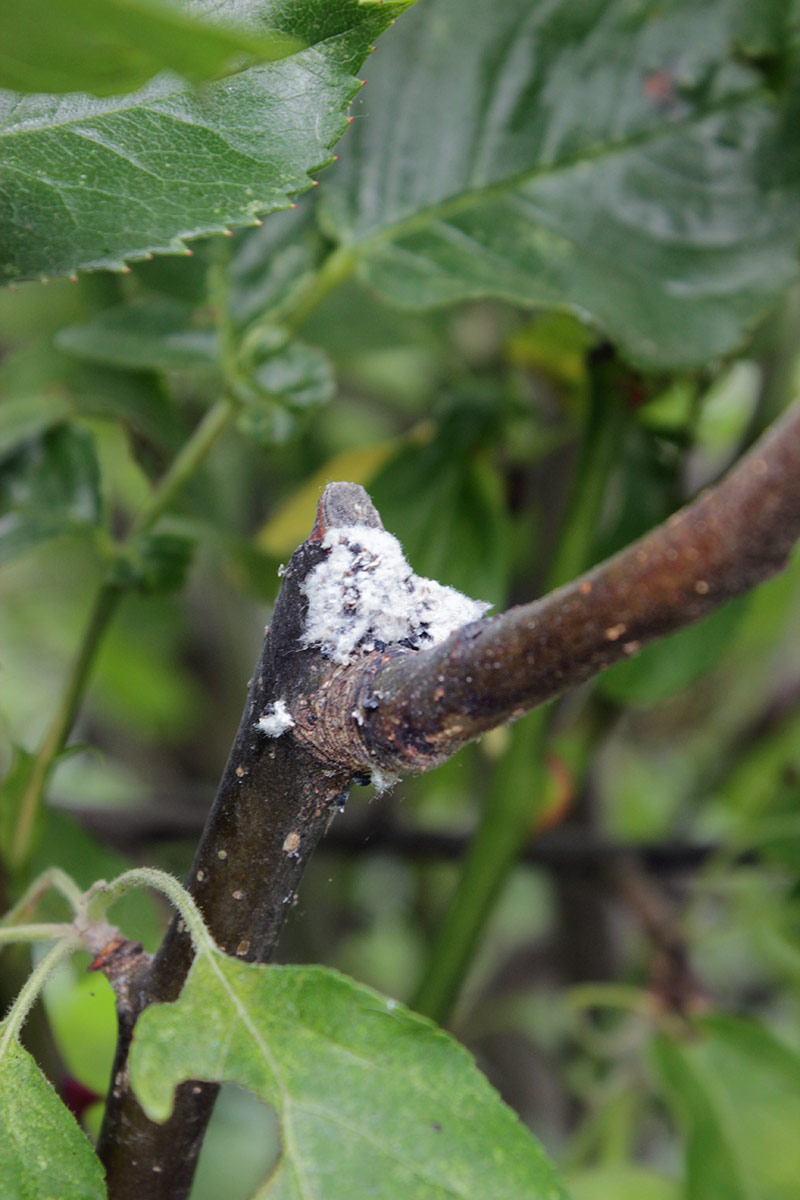 |
And there is a type of fungus on some of the branches. A problem or not?
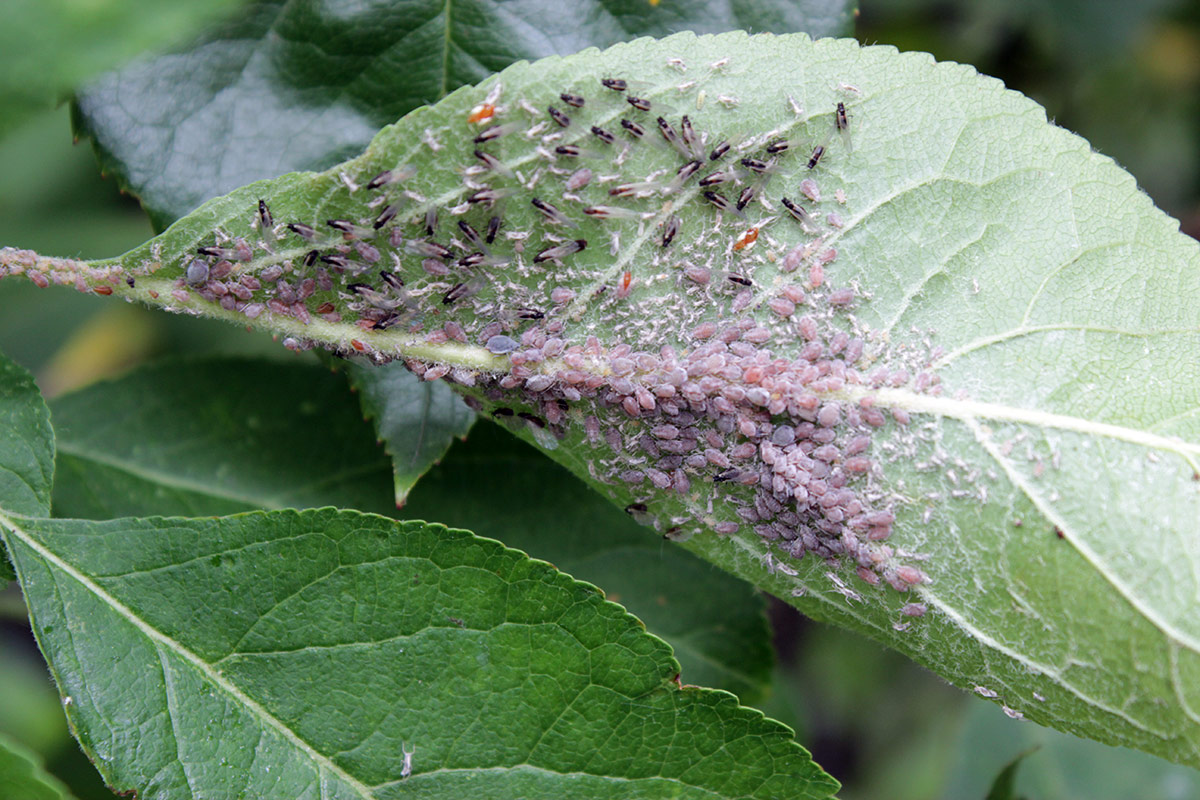 |
The amount of aphids is astonishing, they don’t look like greenflies, must be a different type of aphids. Is there a specific apple aphid? How do I treat a whole huge tree? I can’t possibly spray it, so is there a root soak that would work?
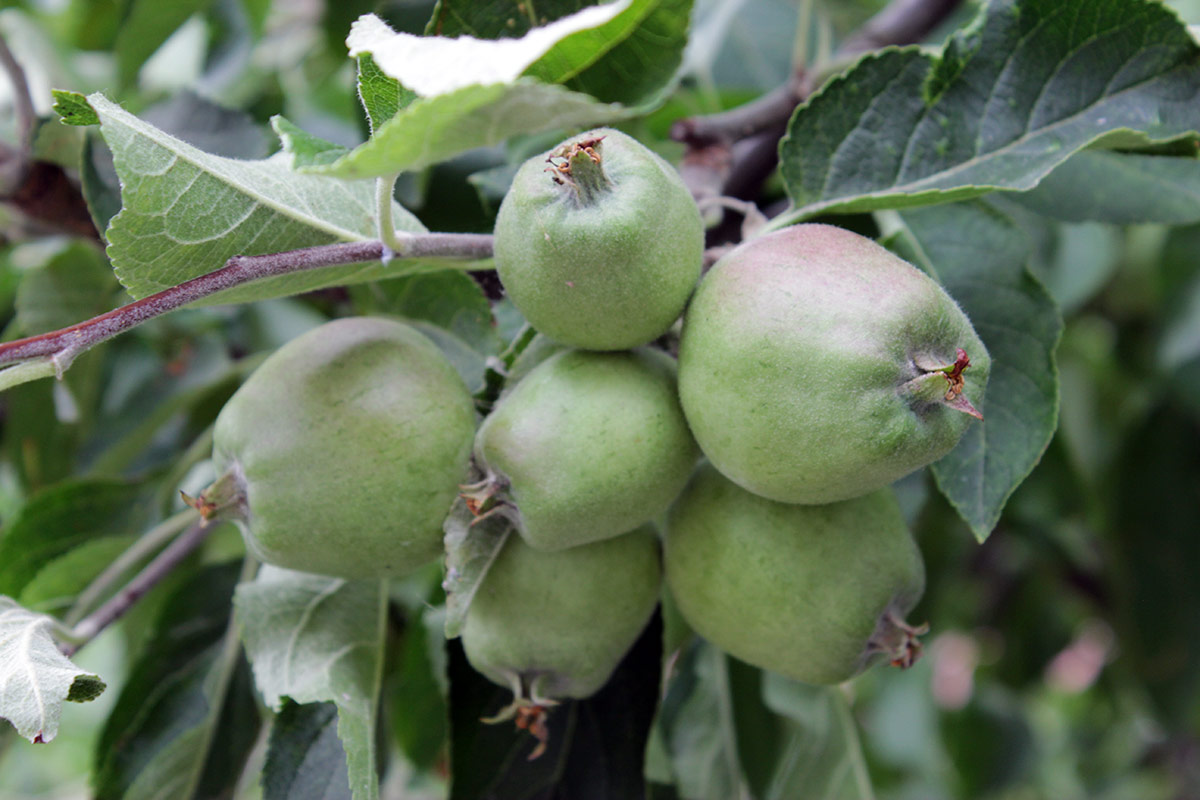 |
Despite all the apparent issues the apple tree has lots of fruit, I haven’t had any June drop as of yet (yep, I have got that far in educating myself!) – so I will give it a bit more time and then start picking off fruit so the biggest ones can grow healthy. When do you pick off surplus apples if they don’t drop by themselves? Do you go by size or the calendar?
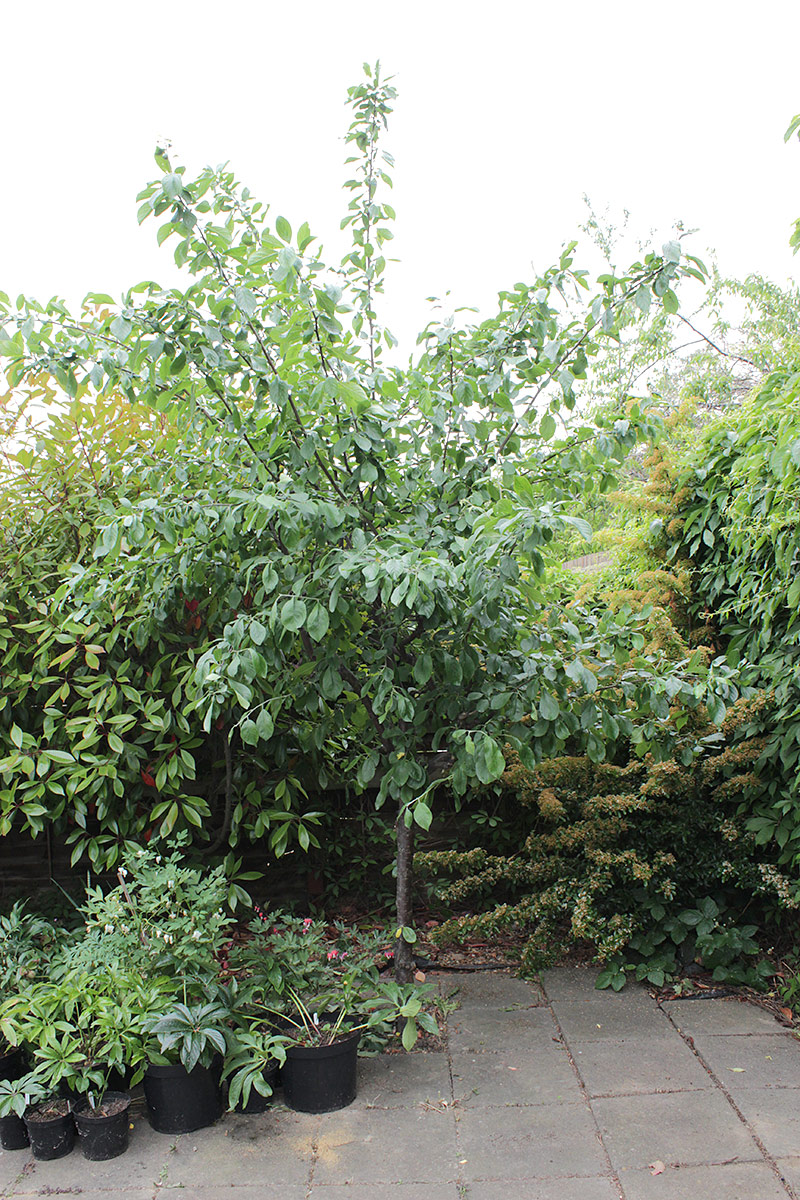 |
Here is the plumtree in my garden, a healthy size too, although not as big as the apple tree. It is covered in aphids and dripping with honeydew.
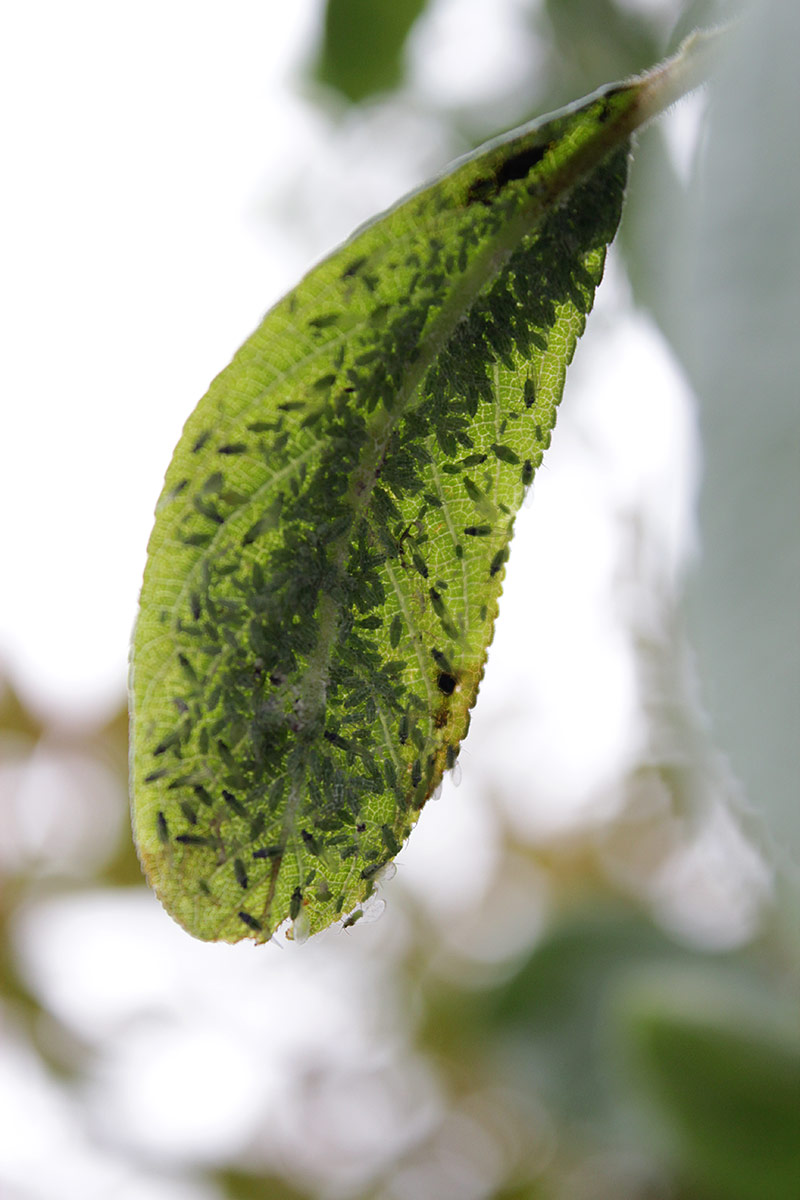 |
The aphids are yet another type – plum aphids?? I tried to hose down the tree with my garden hose set on the jet setting. My water pressure is quite good and on the jet setting I get quite a hard water spurt so I wouldn’t normally use it on any of my plants, but I thought it was worth trying it on the plumtree. The result was one very wet gardener and all the aphids were still there after I was finished. So much for that advice, photo taken after tree and gardener had got dry again.
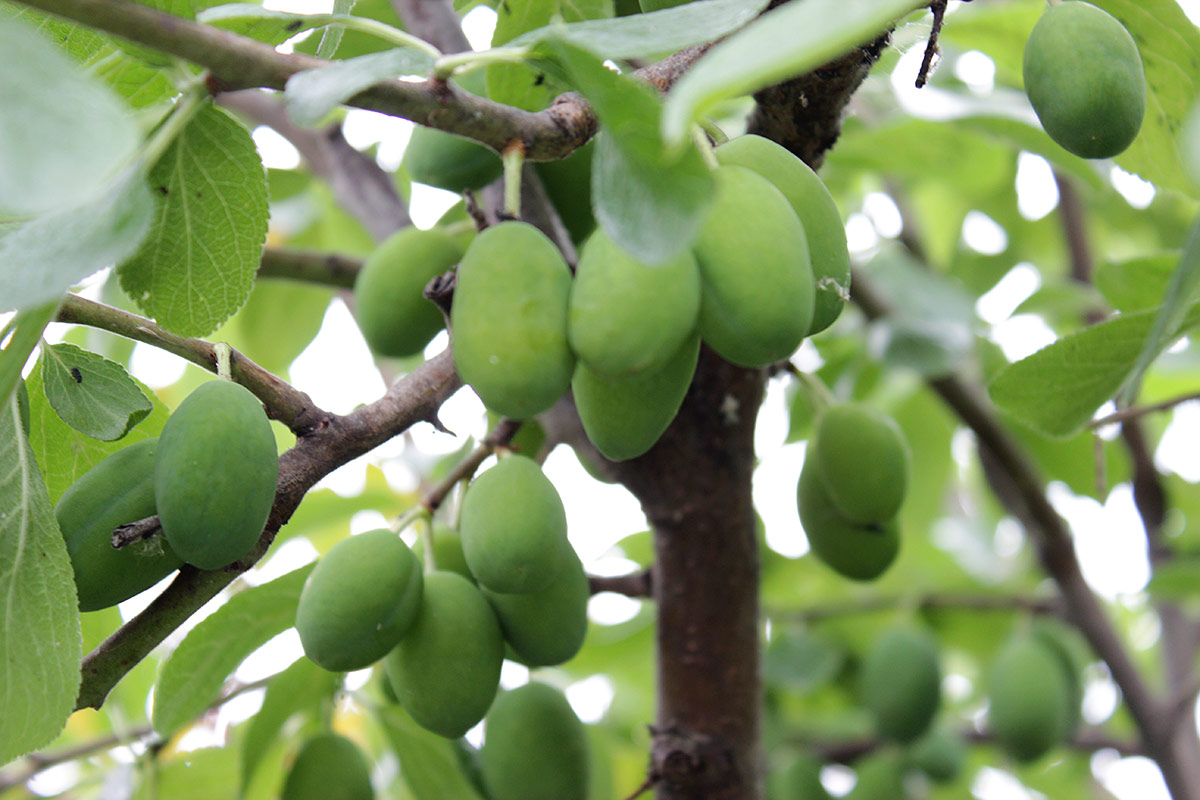 |
There are loads of plums, not sure what type but time will tell I guess. No June drop here either so far, so when do you thin out your plum trees?
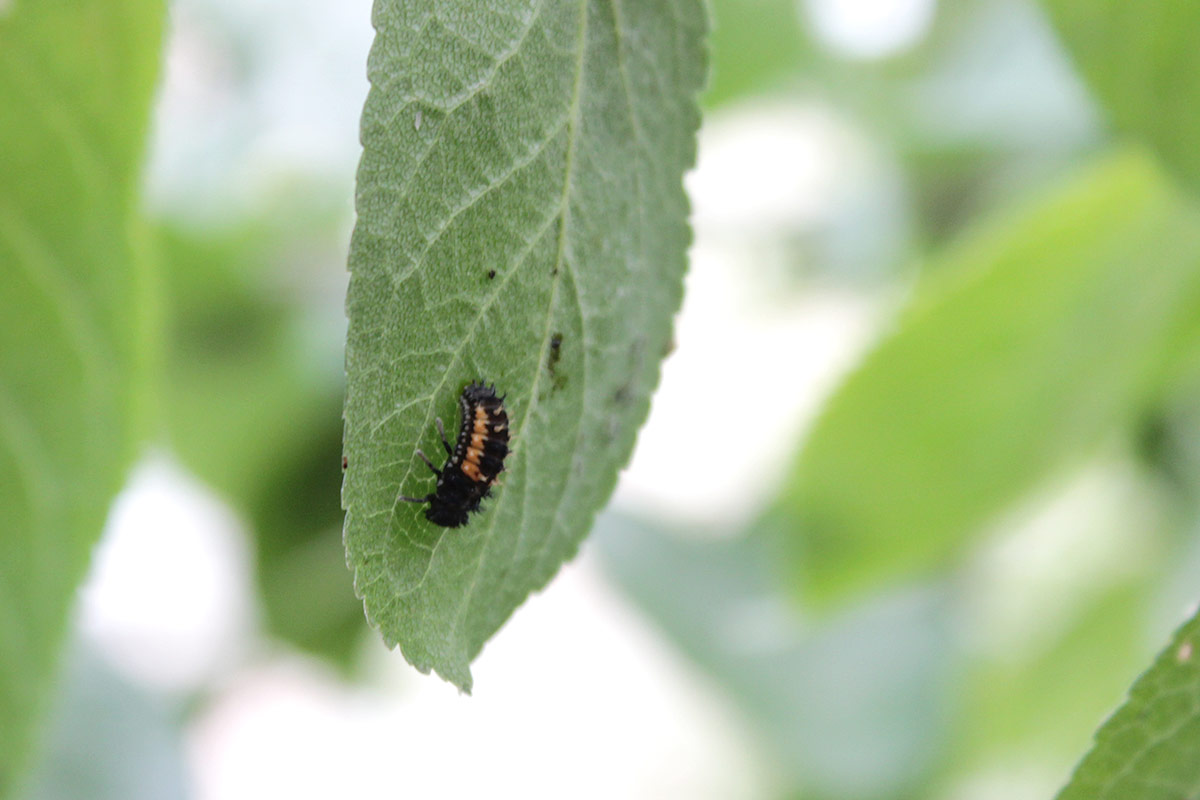 |
There are signs of ladybird larvae having arrived on the plumtree, it was a relief to see them as they can eat an astonishing amount of aphids. Perhaps the problem will sort itself out in the end. Perhaps I could carefully transfer a few (hundred) ladybird larva to the apple tree to help out there too, there doesn’t seem to be any there yet.
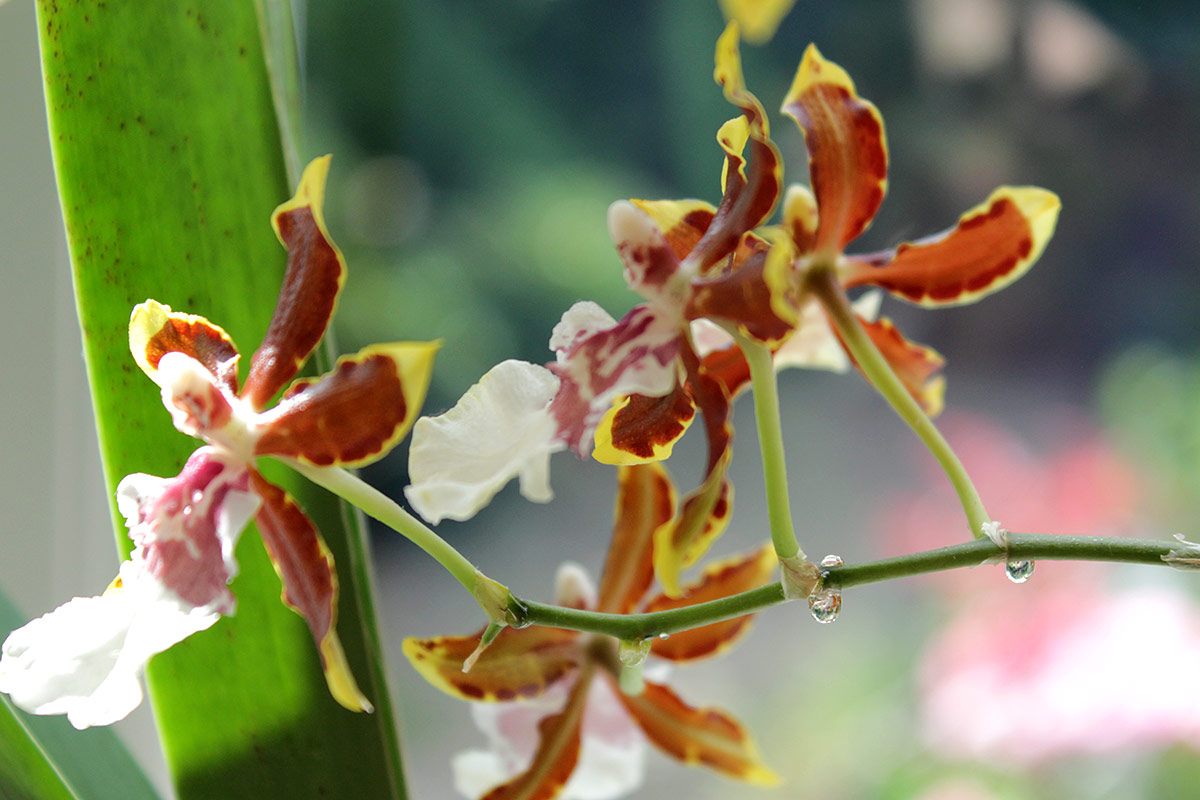 |
Speaking of dripping honeydew, have you ever had dripping, sticky water from your plants, especially houseplants? The first time it happened to me I thought I had an aphid infestation in my living room and could not understand why I couldn’t see any aphids. This phenomenon is called guttation and is perfectly normal, sometimes a sign of overwatering or plants being watered at night when they don’t like that – but most of the time it’s just a healthy perspiration, just like you and me do. Freaked me out the first time I saw it! This orchid is a Cambria, a newcomer to my collection this year, it has not got used to my nocturnal life – and subsequent watering regime, it just has to conform like the rest and it will be fine :-)
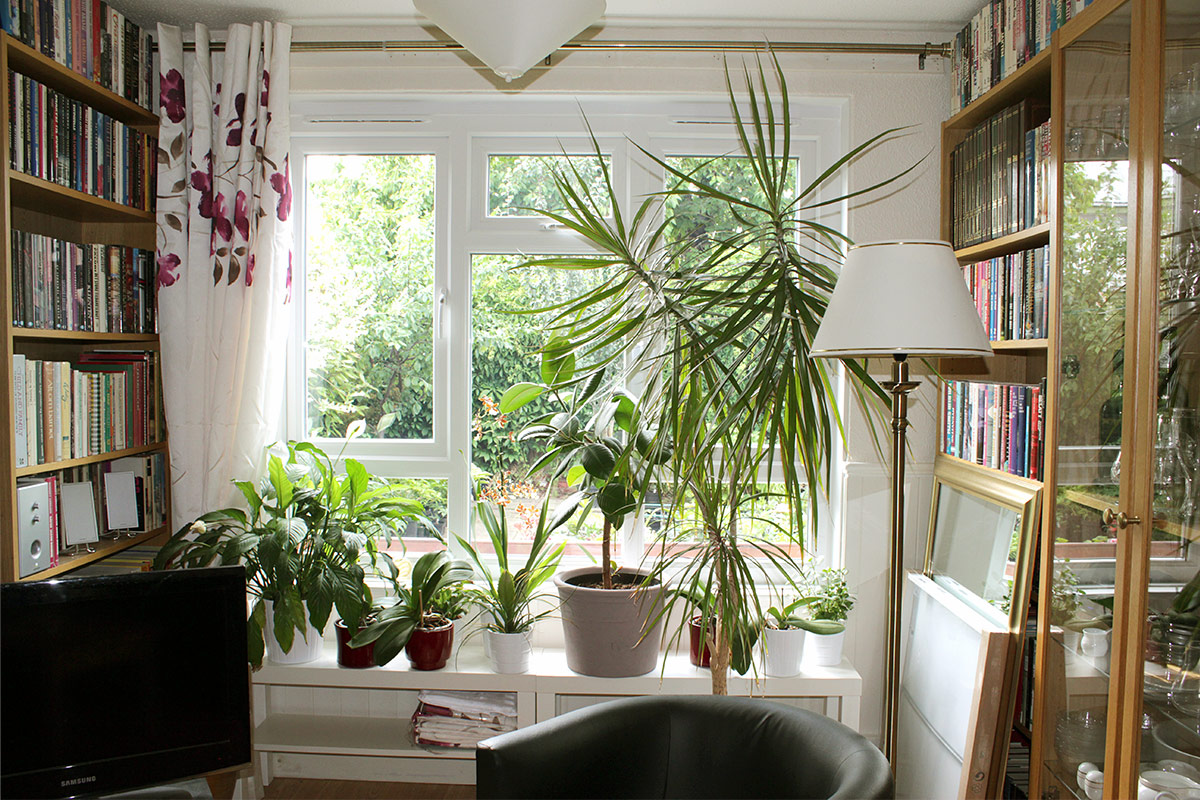 |
As for my houseplants, they have a much better life in my new house than in my old one where all my windows had a radiator under it. Here is my living room window, this is my view from the sofa and the garden is right outside. Another top on my wish-list – to be able to see my garden from my living room. The houseplants here have lots of light and only a bit sun in late afternoon in the summer. Perfect for plants. As you can see I have still lots to do here, only one curtain up so far and the two mirrors on the right side have been standing there for weeks. The garden takes priority of course!
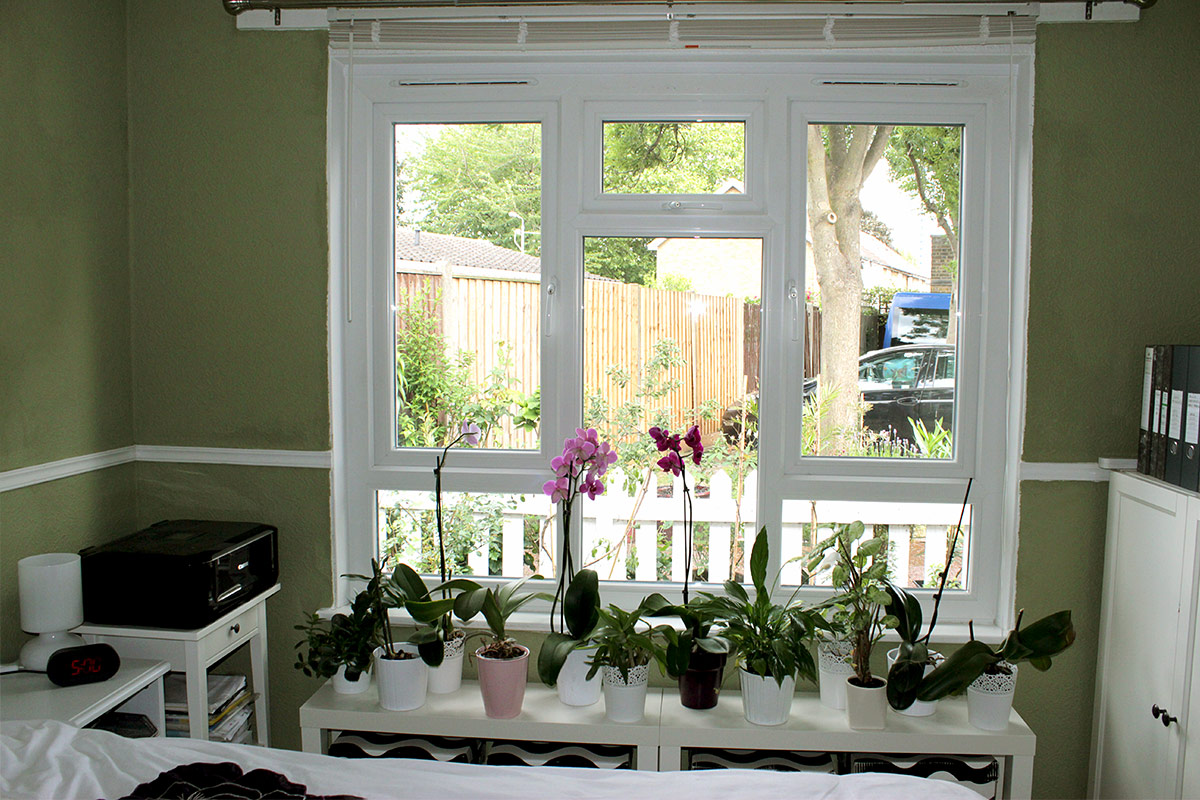 |
Here is the bedroom window, identical to the living room window, with the rest of my houseplants. I usually buy at least one orchid every year and since they are quite happy in my household I am now the owner of 14 orchids of various types, plus a good few other types of houseplants. In my old house they lived a very cramped life, some even had to camp out in my bathroom as I had very little space for them. Here in my new house I have space for many more as you can see :-) Oh, and curtains for my bedroom is coming, soon. I have got blinds installed which I am lowering at night, but somehow curtains haven’t got priority yet. My garden you know…..
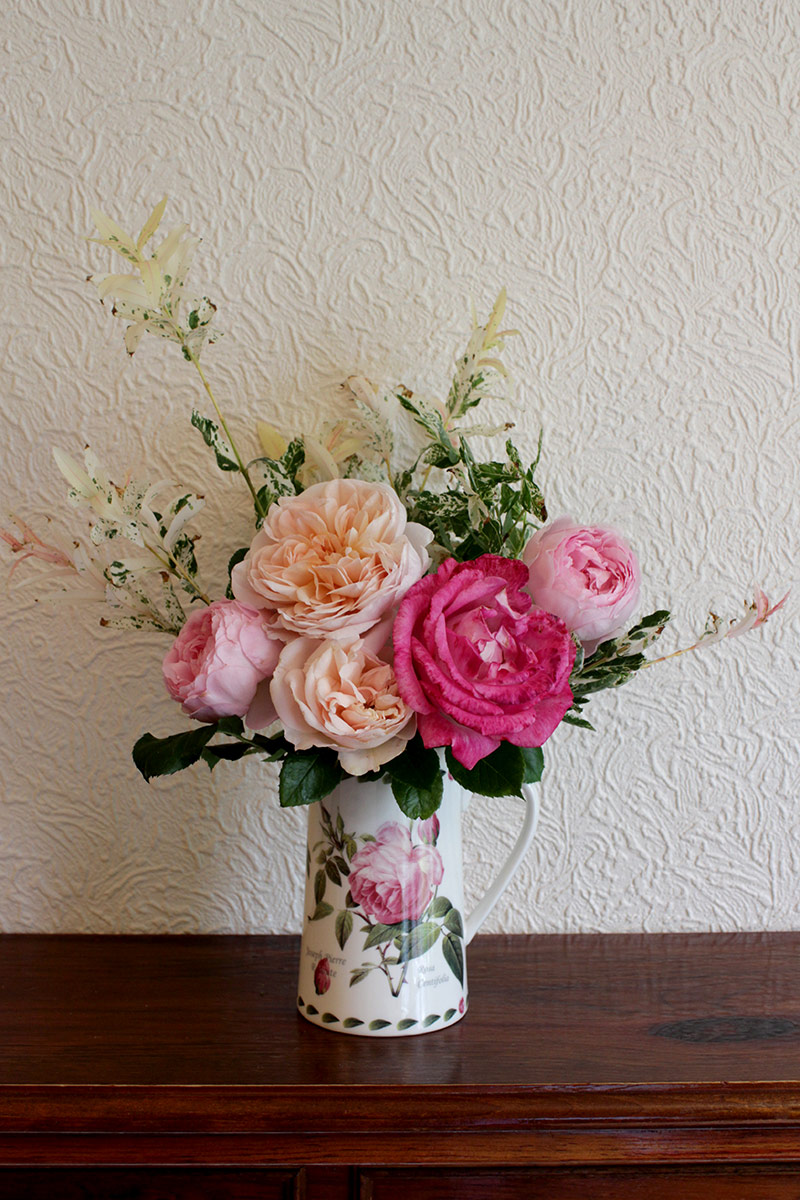 |
And finally, my vase for the ‘In a Vase on a Monday’ is very pink and with all my roses in full flush I had to fill it with roses again. There’s one of the beautiful, unnamed one growing in the apple tree, one of the unnamed from the front garden, one of 'Wildeve' and two of 'Scepter'd Isle'. In addition I have used twigs from the Pink Variegated Willow, Salix integra 'Hakuro Nishiki' as I think they look so beautiful still. They are starting to turn paler and greener and losing the pink colour, but I am so happy I got to see it at this time of year when moving in.
As the title of this post indicate, this is just the first part of a post where I try to describe some of the issues in my new garden, hopefully some of you knowledgeable good people out there will have hints and tips for me to help me on the way. The second part of this post will be part of the End of Month View post on the 30th June and I promise more issues to dig your teeth into :-)
I am linking this post to In a Vase on a Monday with Cathy at Rambling in the Garden.
Until next time, take care.

Wow... I like your new garden, even you have not finish to make over it yet. Both of flower and fruit plants inside, so complete. I couldn't wait to see your lilies get blooming. Happy gardening on your new garden!
ReplyDeleteThanks Endah, my lilies will soon be flowering, one after the other and by mid-July there will be an explosion of lily scent around here :-)
DeleteA lovely arrangement for the "vase" meme! So many things to think about, and of course I am not an expert on these issues. But I can share from some of the experiences I've had. Regarding the compacted, hard soil, how about practicing the "lasagna method"? I have very good soil here, but sometimes when I want a new garden bed without heavy rototilling, I lay down newspaper or cardboard over the grass or soil, followed by several layers of soil, then compost, then more newspaper, then more soil, then mulch. It works well, and sometimes I even plant in it right away (although some folks recommend waiting a few months to let everything break down). Regarding the apple trees: I don't have any now, but we had three at our old house. They can take some heavy pruning, but of course you want it to coincide with off-season for fruit. Here's a diagram I found that might be helpful: Apple Tree Pruning, but I have to be honest: I usually simple went at it and pruned what seemed to make sense. They are forgiving trees, in my experience. Regarding the aphids and other pests, I wonder if beneficial predator insects would help? Lady beetles? I hope this helps a little bit. Your new view from inside is lovely!
ReplyDeleteThanks Beth, I know about the lasagne method, only problem is it takes such a long time and I really need to start planting pretty soon. Water and black plastic is the quickest method I know of, it takes about a week, but is a lot of work, I was hoping for something easier I guess. The problem now is that the soil is so rock hard I can’t even get a spade in even if I wanted to, so planting anything is out of the question without doing something to the soil.
DeleteThanks for the link about apple tree pruning, I don’t think I will worry too much about losing apples this year, I will rather get the garden sorted and prune what I can so I will do like you, just have a go at it!
We can buy ladybirds online here in UK, they are rather expensive but it is possible. Hopefully the ones I have on my plumtree will migrate to the other trees in time?
Your garden challenges are exciting, if also daunting! Is the soil baked clay? We have some of that, which we addressed by deep soaking, then digging, followed by the addition of imported topsoil and soil amendments to create modified berms. I was lucky to have my husband do a good portion of the digging and roto-tilling. Regarding the Ceanothus, the conventional wisdom here is to avoid cutting any branch larger than one inch (2.54 cm) in diameter and to rely on tip-pruning to shape the plants (which isn't very helpful if the shrubs have been neglected for a long period. Still, although common here, Ceanothus have a reputation for being short-lived. I inherited two long sections of Ceanothus hedge, both very twiggy underneath, and I've lost 3 of the component shrubs just this year, although our drought may be a factor there.
ReplyDeleteYour house has beautiful light and I love your vase! My own roses have already been done in by the heat so I'm going to use Cymbidiums in tomorrow's vase.
Thanks Kris, I am not really sure why the soil is so hard, to be honest I am not really fit for any type of digging – with my health issues I have tried to avoid digging at all and it worked well in my previous garden. I had a lovely soil and could just sit on my stool and use a trowel or garden fork whenever I wanted to plant anything or lift anything out. Remember I lifted all the plants in my garden that way, easily! In this garden I can’t even get a trowel in to lift small weeds. I am not very good at wheelbarrowing soil around either, not easy with a crutch in one hand – or both. Besides, I haven’t got any surplus soil yet, not until some has been dug up. So….I need to find a way that doesn’t involve a lot of muscle power or paying for soil that needs to be spread. I am still thinking :-)
DeleteHelene,I love your wonderful vase with its coordinating roses! Regarding your compacted soil, I was going to suggest the same method PlantPostings just did. Other than "lasagna" gardening, the only other suggestions would be either a true raised bed or else hire a strong man with a pick ax and add LOTS of soil conditioner! Before my hip replacement I used to attack my own concrete-like clay soil with a pick ax, and this worked very well - though I can't say that it helped my hip!
ReplyDeleteAlso, it would be safe to prune out dead wood from your ceanothus at any time. Otherwise, light tip pruning is OK.
I have two apple trees, and I spray them several times through spring and summer with horticultural oil such as NEEM oil. This helps with both bugs and fungus. If you want to remove some of the fruit to allow the other apples to grow larger, now is a good time to do it. Just pick the smaller ones and leave one or two larger ones in the cluster. It is OK to leave them all, but the fruit will be smaller.
Best wishes! Deb
I wish I could hire a strong man – or two, that would solve my problem! I have heard of a retired man in the area that is relatively cheap, I will ask for him to come and have a look and give me a price to remove the roots of the bushes I have cut down so far. Perhaps someone fit and well won’t spend too long on a job like this but it will take me days to get each root out.
DeleteThanks for the tip about pruning the ceanothus, I will try to get rid of some of the dead branches. I can’t imagine how to spray a whole apple tree, but I haven’t tried yet – possibly on a ladder? Another job for someone I will have to pay I think!
How tall is the apple tree? I have a sprayer that can reach up to 25 feet (7.6 meters), which is high enough for me, as we prune our dwarf apple trees to about ten feet (3 meters) each spring.
DeleteI haven’t measured the apple tree, but I would guess it is about 4m tall – and very dense, I would like to thin it out quite a bit early next spring. I have already looked at some battery operated sprayers on Amazon, but those at a reasonable price meant for amateur gardeners don’t seem to be made for spraying UP, but rather with a lance to spray shrubs and plants, or weeds on the ground. I am also worried about carrying such a thing around, most of them are quite heavy, my manual plastic sprayer takes 2.5 litre and carrying that over my shoulder when full is just about what I can manage.
DeleteWhat kind of sprayer do you have?
I love your new orchid, Helene. Very pretty flowers and now you have 14 of them! mine are not well this year, may be I often water them? I see your garden is getting tidy and your bench and garden table are in their place, very nice.
ReplyDeleteWhat can I say about your fruit trees? I think you will have apple and plum jam, am I right? These trees have many diseases and aphids every year. Nickolay cuts their ill branches early in spring and I spray them too. Have a nice week!
Thanks Nadezda, I can’t get enough of orchids and I am so happy I have room for them all here in my new house. I don’t water them very often, once a week or maybe 10 days is enough and in the winter usually every 14 days. But I soak them for a few hours every time they get water and then drain well. Some of my orchids are more than 10 years old.
DeleteI understand that keeping fruit trees will involve more disease control, I just have to get educated about what to do when. I think next year will be better as I can start with things from early spring.
Waiting a year to see what secrets the garden held was never going to happen with me either Helene. The leaves of your unknown plant looks very much like those of crinodendron, a shrub we had in Aberdeen borderline up north but managed to survive and bloom.
ReplyDeleteCeanothus your, kidding, actually, I know your not but that is some specimen.
Hi Alistair, I don’t think the shrubs are crinodendrons, the dead flowers are not looking at all like the flowers from a crinodendron, I know what they look like as I tried growing it in my previous garden but it died after a few years. The bushes are making new flowers now so when they are out it will probably be easier to see what it is. I will post new photos when they are properly in flower.
DeleteNot sure what you meant to write about my ceanothus, seems to be part of it missing, but I understand you are impressed by its size :-)
(Ceanothus your, kidding), just my tongue in cheek way of saying, wow I have never before seen such a large specimen. I must think you are a mind reader Helene..
DeleteHelene there is so much bounty and beauty and potential here but I hear you when you say hard soil....I used to do a cheating lasagna method where I laid layers of peat and then top soil or compost and top soil and just planted into the new soil....it worked for the most part, but if you are looking to get rid of weeds and grass, then your black plastic might be the quickest way and then layer soil on top of cardboard of newspaper...I did this too. Not the best methods but some quick ones.
ReplyDeleteLove the interior of your house especially the bedroom window.
Thanks Donna, yes I might have to resort to water and black plastic because to be honest, despite my lovely previous garden I don’t do digging, lifting, running around with wheelbarrows, spreading soil or any of that stuff – I am not physically able to. I can sit on a stool and do gardening, and I managed that in my previous garden, so I have to find a way to do that here too. And I can’t pay for bags and bags of compost either, in a garden of this size it would be very expensive. So – water and bags I think it will be. Although I will have to pay someone to get the grass lifted, that’s going eventually and I won’t be able to do that so once the grass is gone I hope the soil under it isn’t too bad.
DeleteThe view from my bedroom window is something I really appreciate, I didn’t have a view from any of my windows in my previous house and now I can sit in my bed and look at my orchids inside and out on my front garden :-)
To break up my compacted clay soil I used a product called Penetrate sold by a company called John and Bob's. It works miracles but I'm not sure if they ship to the UK. I poked holes in the soil with a pitchfork and then applied the solution. It broke the clay up enough that I could dig into and add compost. I'd take down the barbed wire, too! What a weird addition to a garden.
ReplyDeleteThanks for the info, it doesn’t seem to be any similar product over here but long term I will add bark mulch in all the beds just as I had in my previous garden, that will help a lot, but will take time, years I suppose. In the mean time I need to get my plants in the ground.
DeleteI see barbed wire like that around here many places, I assume people think it stops thieves from climbing in – it doesn’t. If people want in they get in, no matter what.
I thought I had commented on this - it must have disappeared..
ReplyDeleteThe woolly fungus like stuff is woolly aphid. I brush it off our trees with an old toothbrush but if you have a lot or it is high up this may not be practical. We spray our trees with a vegetable oil based winter wash when they are leafless.
What about some early spring flowers at the front that will be over by the time the trees leaf up. We have hellebores, snowdrops and primroses in a similar position.
As for hard ground maybe some rain will help and them lots of organic material
I think you need to write to Gardneers' World and get Carol Klein to help.
I wish we had lots of rain Sue, weeks of rain would have been nice, at least if it came at night! We haven’t really had much rain down here since February so the ground is very dry, and in my garden it is especially dry. I have actually thought about writing to Gardeners’ World – I guess I won’t be the only one asking for help though but it would be worth a try, you never know, they might take an interest!
DeleteMost people have commented on the things I am, but nevertheless; dead,diseased, and crossed branches can be cut at any time; if you can hire some one to break up the soil do it, otherwise aged compost is the best amendment for any soil condition especially if you are going to plant in it soon; I agree with the wooly aphid diagnosis.
ReplyDeleteIt is going to be a beautiful garden, better than the last :)
Thanks Pat, I know it will be a better garden – eventually, I just have to get the hard landscaping and the beds sorted so the fun bit can get started :-) I can see I will have to pay for some help in the garden, I am on to it as this is no job for someone in my situation. But I will try to water and pay plastic some places once I have pruned and cut down a bit more. Slowly, slowly getting there!
DeleteOh, my, I am daunted just reading this! Thank goodness you included that beautiful vase of flowers at the end to restore my spirits!
ReplyDeleteObviously, the first step is to improve your soil and as you noted that will be a difficult task with soil so compacted. My first thought was the same as PlantPostings' suggestion - the lasagna method. But since you want quicker results, the only thing I can suggest is deep soaking to soften the soil and make it easier to dig so that you can add mass quantities of organic matter to improve the quality. Whatever you decide to do, good luck with it. I look forward to reading about your adventure.
Hi Dorothy, with the weather we have right now – and for the foreseeable future – all I am doing is trying to keep my potted plants alive so I am watering like mad, every evening. I have placed a lot of the pots INSIDE the beds rather than on the patio, hoping that some of the water will drain down in the soil and be of benefit there. Time will tell :-)
DeleteHei Helene!
ReplyDeleteDet er så spennende å følge deg og din nye hage! Imponerende liljesamling du har! Jeg er også veldig glad i liljer, men irriterer meg grønn over liljebiller. Er du ikke plaget med det hos deg? Her står alle mine martagonliljer med store knopper nå. Har du noen av de? De er de første som blomstrer her av de jeg har. Ønsker deg en fin uke videre!
Hei Marit, her har det ikke blitt mye blogging i det siste, men nå kommer det endelig et svar. Jeg er ikke sikker på om noen av liljene mine er martagon liljer, har kjøpt fra mange forskjellige leverandører og ikke alle er like flinke til å gi fullt navn. Men jeg har sett mange fine liljer fra H.W Hyde og bestilte noen derfra i vinter. Venter spent på at Blueberry Crush skal blomstre :-)
Deletehttp://www.hwhyde.co.uk
Jeg har også problemer med red lily beetles, men pleier å spraye med dette middelet hver 4 uke: http://www.bakker.co.uk/product/pireco-foliar-for-insects
- og det er det beste jeg har prøvd for lily beetles, og også aphids og hjelper også for red spider mite. Vidunder middel, kan ikke klare meg uten! Jeg snakket akkurat om dette for noen uker siden til svigerinnen min i Oslo, sa hun burde bruke det på rosene sine, Bakker finnes i Norge også – men så viser det seg at de ikke selger akkurat dette i Norge. Hvorfor aner jeg ikke, for dette kommer fra Nederland, er ikke produsert her i England. Du kan jo kanskje sende dem en email og spørre om de kan starte å selge det via den norske websiden også. Hvis de gjør det anbefaler jeg det – er helt ufarlig for andre insekter inkludert bier. Men ikke bland det innendørs, det lukter pyton! Bland det opp ute. Jeg bruker det som soil drench og som spray, 1 gang pr måned i jorden og top-up som spray når det er ekstra ille med roselus.
You can take out whole branches to thin out and you can remove dead branches to your hearts content on your ceanothus.
ReplyDeleteWhether you can cut back into dead growth for it to regenerate is more doubtful.
If you were to decide they were expendable you might be very surprised that they do have some capacity to regenerate but no guarantees
Your soil may be hard but looking at the growth on some of your plants it has a great deal of potential
Thanks Roger, I was hoping I could at least get rid of most of the dead wood yes. Having looked more closely under the canopy I think it will be rather difficult to get rid of all the dead bits as many of the branches have green leaves right at the end and nothing further in – if I removed too much I would end up with no leaves. I will start a bit careful and see how it goes. Not a priority right now, I am watering my nearly 700 pots every day and trying to keep them alive!
DeleteI have been pondering your exciting project HELENE.
ReplyDeleteYou need to do some ruthless pruning and give great thought to what you want to keep. It is amazing how many overgrown things can be rejuvenated by hard pruning. You can do this at ANY time of the year.
I would give some thought that with all your wonderful plants that it is worth keeping manky fruit trees in such a small garden. Be prepared to be ruthless but don’t throw babies out with the bathwater. Any large shrubs or trees you don’t want can be cut flush to the ground. They will often regenerate – let them if you want them otherwise keep cutting new growth back until the root dies. (I imagine you don’t use herbicides as I do)
You don’t mention perennial weeds such as ground elder and couch. It looks as if you might be free of them. Thank goodness! If I am wrong you must get rid of them before serious planting.
Your soil looks alright to me! Things seem to grow well. Don’t confuse a settled hard surface with compaction. Of course without seeing the site I cannot be sure. Heavy watering will soften the soil more than any useless magic potions. Do NOT pay anyone to do major excavation for you.
I would just make a hole breaking up the soil a little around the immediate perimeter and just plant.
Your soil will be improved by the same kind of organic matter you so successfully used in your old garden.
A rather way out suggestion might be to use all the copious prunings you have to improve the soil!
When I made a half hearted effort to plant a border in my son’s small garden on London clay he had a whole stack of woody prunings to dispose of. I buried them a spit deep at the bottom of a digging trench I dug. Yes I dug – I did confess it on my blog! I was absolutely amazed two years later how Ben’s soil had improved.
I think that shrub is a form of the cherry laurel. It is excellent for motorway roundabouts or Tesco car parks.
PS Just looked at your plums! They are rather good!
DeleteI was pretty ruthless in my previous garden when I started at first, not much was worth keeping and I did exactly what you are saying, pruned things to the ground, some things came back, other things were never to be seen again and that’s how I selected what to keep and what to chuck. The difference is that I didn’t have nearly 700 plants waiting to be planted back then when I did my previous garden – there is a bit more urgency this time :-)
DeleteI am not sure how to spot ground elder and couch, never had to deal with it before so I don’t know if I have it. There are lots of weeds between the paving slabs though as there is no screen under it, but I will remove many of them and make the beds much deeper so will have the weeds taken out before planting.
And no, I won’t dig up and turn my beds, just as I didn’t dig in my other garden, I want to make the soil as lovely as I had it in my previous garden – I just haven’t really got 4-5 years to wait for it to happen!! So yes, if I could just manage to get the plants in the ground – then I and the plants would be happy. As a first try I have moved many of the pots into the existing beds and I am watering the pots in the beds so the water will drain off on to the soil and down into the ground. Hopefully over the summer that will slowly make the ground loser and more manageable. My son has promised to do several trips to B&Q and buy bark mulch for me when he is off work in middle of July so that’s when I will start taking off the tatty old liner and the gravel that is not so successfully covering the beds right now.
Thanks for your long and extensive reply Roger, much appreciated – and yes I hope my plums are good, never grown plums before :-)
Helene, I can't offer much advice, but I can see you already have some great suggestions from other commenters. I would say to be careful what you plant under the apple tree, nothing too delicate. In the fall, the ground under my apple tree is littered with apples, so I'm glad I don't have anything planted there that would be crushed by them. I know you will find solutions as you go along and have a beautiful garden once again. What a lovely view from your windows!
ReplyDeleteOh, that’s a good advice Rose, thanks! That’s something I suppose I would have found out myself too, AFTER I had planted something nice under the apple tree. Well, I learn something every day :-)
DeleteEvery visit to your new garden brings new discoveries for me. There is such a tone of appreciation and excitement in your descriptions, I tip my hat to your continued energy. I can hardly wait to see what it will look like when you have everything in the ground!
ReplyDeleteThanks Rosemary, I am afraid you will have to wait a while to see them all in the ground! But I will get there eventually :-)
DeleteI wish I was living closer by you and could give you a hand to help. But I am confident you will make it your own paradise again.
ReplyDeleteHave a wonderful day Helene.
Thanks Marijke, I wish all of you lived here in London, would have been so nice :-)
DeleteI am slowly working my way round the garden, but a lot of the work now is just about keeping the plants alive in the heat of the summer, more than that will have to wait for cooler days.
All I can do Helene is to agree with Roger's advice particularly about being ruthless, you have to have the mind set that it does not matter if the subject dies, it is unsightly in its present form and just because it is part of the garden now doesn't mean it has to remain so, in other words you have nothing to loose and in many cases may finish up with a rejuvenated shrub or tree. It took me a long time to learn this because as gardeners we always try to preserve life but in the end a clear cut decision now can save an awful lot of problems in the future.
ReplyDeleteThanks Rick, yes I suppose I also tend to think that something that has grown for many years deserve to be given a chance…but on the other hand if I don’t like something I can be rather ruthless – and I was in the beginning in my previous garden too. I have chopped down two more shrubs since writing this post and you can see the result on my end of month view :-)
DeleteI'd be there with bells on if I was nearer Helene. I'd be inclined to go down Roger's suggestion of just improving each planting hole to start with and then as the years go on, as you add more organic matter, like the bark or soil conditioner, mother nature will do her thing. Lifting the rotting fruit is also a must, the wasps can be rather troublesome.
ReplyDeleteWhat about one of these http://www.ebay.co.uk/itm/Kingfisher-Long-Handled-Garden-Cultivator-Weeding-Twist-Hand-Tool-/281111523036 which might help in breaking up the surface of the soil. I use one when I dig out planting holes to break up the soil and mix in compost at the same time. I know you prefer to garden on your stool but at least the design of this gives you a bit of support whilst you are twisting it.
Re the magnolia - I am not sure how this suggestion would work, perhaps take further advice but I thought I'd through it out there just in case it might work. We are told not to add to much compost when planting in the ground as this discourages the plants from searching out for water and nutrients and putting on good root growth. What about if you used this in reverse and add plenty of compost, which would discourage the roots from doing as they should, thus making it easier should you have the need to move. If next year you find that you don't need to move it, you could lift it and replace some of that compost with soil.
Don't be disheartened by some of the issues you are finding, rome wasn't built in a day!
Thanks Angie, I know you would have been here if we lived closer – I wish we all lived closer to each other!
DeleteI looked into the tool you suggested and I have just bought it – from Amazon, it will turn up within the next 10 days, it looks like a useful tool and at that price I can afford to test it out, Thanks for the tip!
As for the magnolia – I am afraid the planting hole for that big root ball is going to be so huge that it will need to be dug once and only once – and not by me, probably by someone I will have to pay so I would like to get it right the first time around. I am used to clearly defined shady areas from my old garden, here in my new garden it seems to be sun everywhere at some point during the day – not really got my head around that yet.
I wish I knew more about fruit trees and could offer more advice. Your interior spaces look bright and sunny. It will be nice to have a better spot in this house for your houseplants.
ReplyDeleteI am sure you are anxious to get the everything into the ground, but the plants look very healthy in their pots and seem no the worse for the wait. Your soil sounds challenging. If the front garden is a small enough area, I wonder if you might have someone dig it out and then replace it. You have lots of work ahead of you, but one day you will look back on this move and think all the work and effort was well worth it.
Thanks Jennifer, I wish I could have someone dig up the beds and replace the soil, would be lovely. On my shoestring budget and limited abilities I will have to find other ways to do it I am afraid. Time and lots of bark mulch did it in my previous garden with no effort from my side, I might just have to do the same here.
Delete